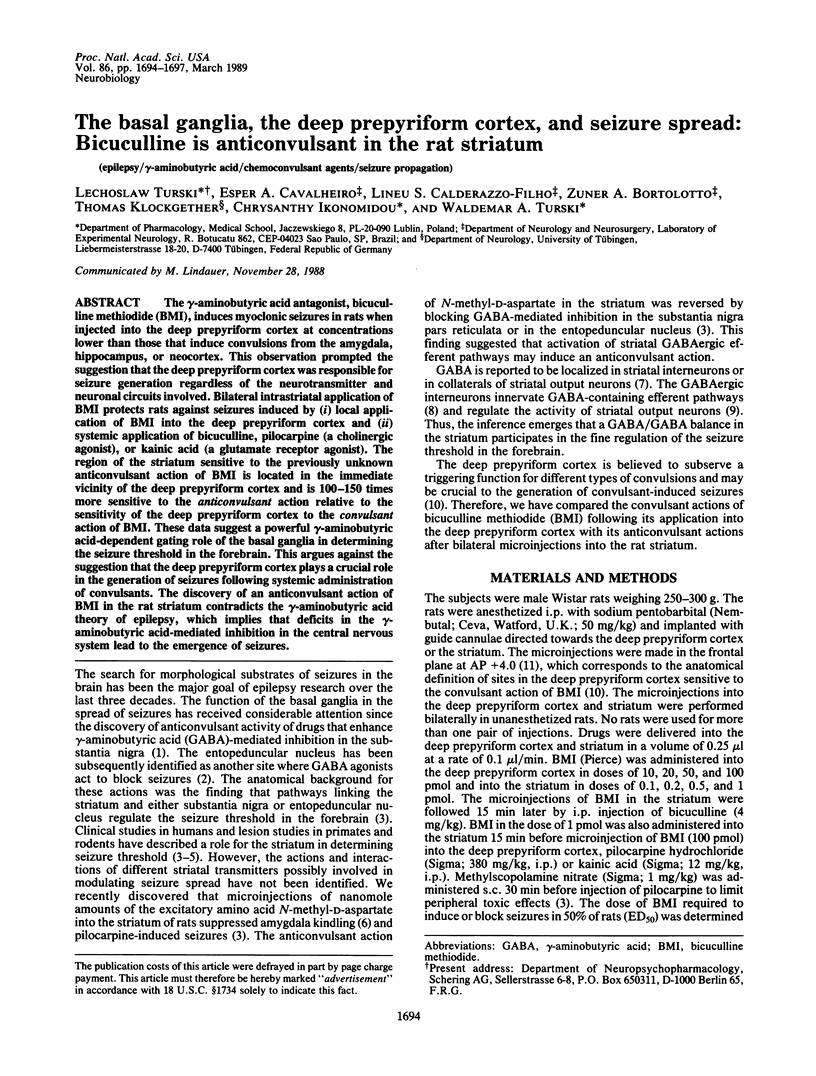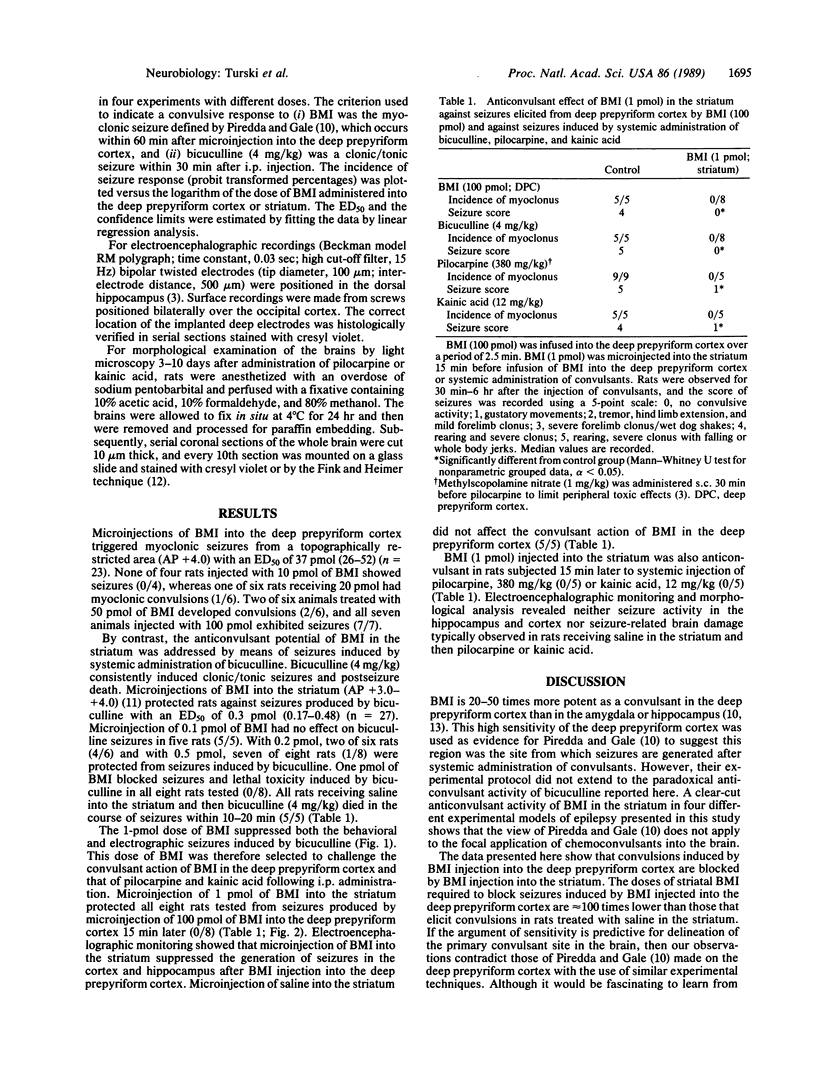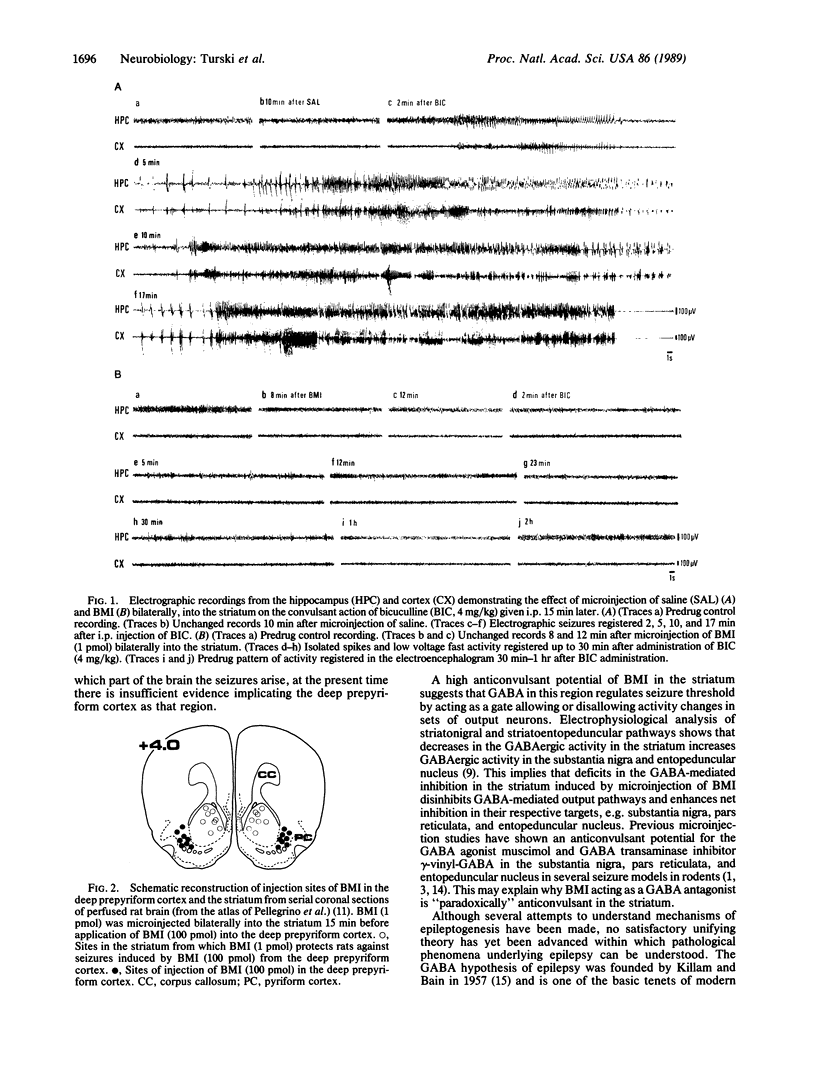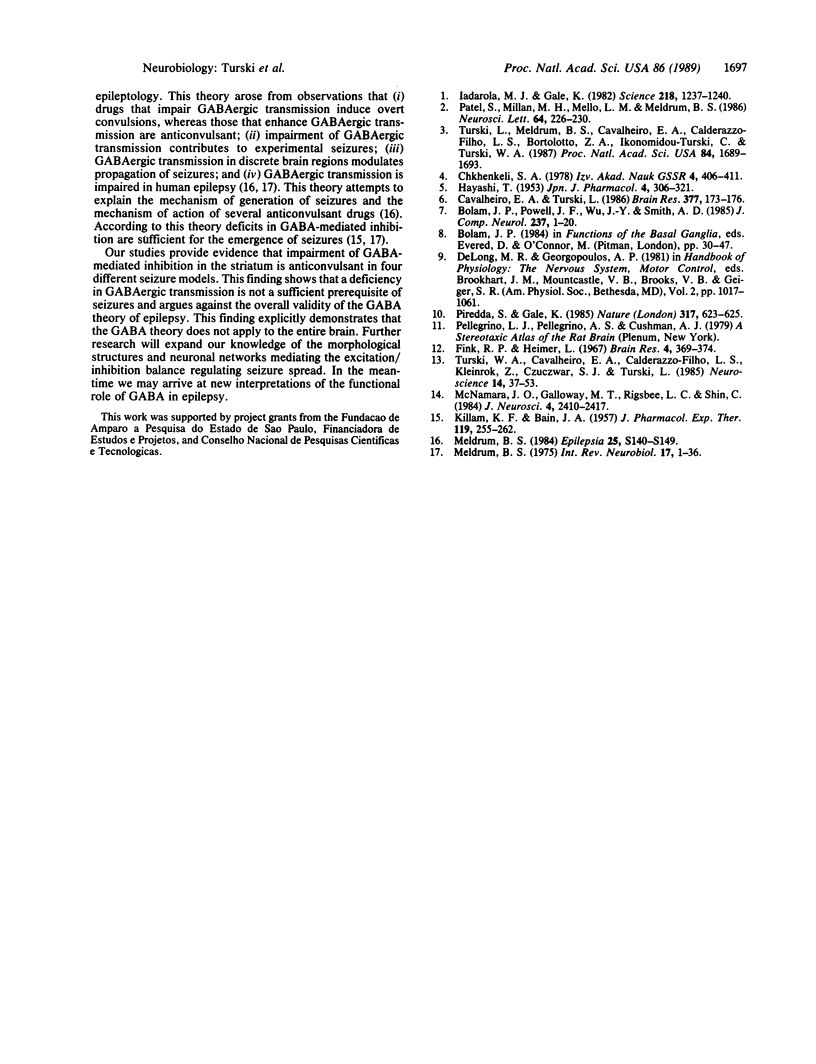Abstract
The gamma-aminobutyric acid antagonist, bicuculline methiodide (BMI), induces myoclonic seizures in rats when injected into the deep prepyriform cortex at concentrations lower than those that induce convulsions from the amygdala, hippocampus, or neocortex. This observation prompted the suggestion that the deep prepyriform cortex was responsible for seizure generation regardless of the neurotransmitter and neuronal circuits involved. Bilateral intrastriatal application of BMI protects rats against seizures induced by (i) local application of BMI into the deep prepyriform cortex and (ii) systemic application of bicuculline, pilocarpine (a cholinergic agonist), or kainic acid (a glutamate receptor agonist). The region of the striatum sensitive to the previously unknown anticonvulsant action of BMI is located in the immediate vicinity of the deep prepyriform cortex and is 100-150 times more sensitive to the anticonvulsant action relative to the sensitivity of the deep prepyriform cortex to the convulsant action of BMI. These data suggest a powerful gamma-aminobutyric acid-dependent gating role of the basal ganglia in determining the seizure threshold in the forebrain. This argues against the suggestion that the deep prepyriform cortex plays a crucial role in the generation of seizures following systemic administration of convulsants. The discovery of an anticonvulsant action of BMI in the rat striatum contradicts the gamma-aminobutyric acid theory of epilepsy, which implies that deficits in the gamma-aminobutyric acid-mediated inhibition in the central nervous system lead to the emergence of seizures.
Full text
PDF



Images in this article
Selected References
These references are in PubMed. This may not be the complete list of references from this article.
- Bolam J. P., Powell J. F., Wu J. Y., Smith A. D. Glutamate decarboxylase-immunoreactive structures in the rat neostriatum: a correlated light and electron microscopic study including a combination of Golgi impregnation with immunocytochemistry. J Comp Neurol. 1985 Jul 1;237(1):1–20. doi: 10.1002/cne.902370102. [DOI] [PubMed] [Google Scholar]
- Cavalheiro E. A., Turski L. Intrastriatal N-methyl-D-aspartate prevents amygdala kindled seizures in rats. Brain Res. 1986 Jul 2;377(1):173–176. doi: 10.1016/0006-8993(86)91204-7. [DOI] [PubMed] [Google Scholar]
- Fink R. P., Heimer L. Two methods for selective silver impregnation of degenerating axons and their synaptic endings in the central nervous system. Brain Res. 1967 Apr;4(4):369–374. doi: 10.1016/0006-8993(67)90166-7. [DOI] [PubMed] [Google Scholar]
- HAYASHI T. The efferent pathway of epileptic seizures for the face following cortical stimulation differs from that for limbs. Jpn J Physiol. 1953 Dec 15;3(4):306–321. doi: 10.2170/jjphysiol.3.306. [DOI] [PubMed] [Google Scholar]
- Iadarola M. J., Gale K. Substantia nigra: site of anticonvulsant activity mediated by gamma-aminobutyric acid. Science. 1982 Dec 17;218(4578):1237–1240. doi: 10.1126/science.7146907. [DOI] [PubMed] [Google Scholar]
- KILLAM K. F., BAIN J. A. Convulsant hydrazides. I. In vitro and in vivo inhibition of vitamin B6 enzymes by convulsant hydrazides. J Pharmacol Exp Ther. 1957 Feb;119(2):255–262. [PubMed] [Google Scholar]
- McNamara J. O., Galloway M. T., Rigsbee L. C., Shin C. Evidence implicating substantia nigra in regulation of kindled seizure threshold. J Neurosci. 1984 Sep;4(9):2410–2417. doi: 10.1523/JNEUROSCI.04-09-02410.1984. [DOI] [PMC free article] [PubMed] [Google Scholar]
- Meldrum B. S. Epilepsy and gamma-aminobutyric acid-mediated inhibition. Int Rev Neurobiol. 1975;17:1–36. doi: 10.1016/s0074-7742(08)60205-6. [DOI] [PubMed] [Google Scholar]
- Meldrum B. Amino acid neurotransmitters and new approaches to anticonvulsant drug action. Epilepsia. 1984;25 (Suppl 2):S140–S149. doi: 10.1111/j.1528-1157.1984.tb05646.x. [DOI] [PubMed] [Google Scholar]
- Patel S., Millan M. H., Mello L. M., Meldrum B. S. 2-Amino-7-phosphonoheptanoic acid (2-APH) infusion into entopeduncular nucleus protects against limbic seizures in rats. Neurosci Lett. 1986 Feb 28;64(2):226–230. doi: 10.1016/0304-3940(86)90105-9. [DOI] [PubMed] [Google Scholar]
- Piredda S., Gale K. A crucial epileptogenic site in the deep prepiriform cortex. Nature. 1985 Oct 17;317(6038):623–625. doi: 10.1038/317623a0. [DOI] [PubMed] [Google Scholar]
- Turski L., Meldrum B. S., Cavalheiro E. A., Calderazzo-Filho L. S., Bortolotto Z. A., Ikonomidou-Turski C., Turski W. A. Paradoxical anticonvulsant activity of the excitatory amino acid N-methyl-D-aspartate in the rat caudate-putamen. Proc Natl Acad Sci U S A. 1987 Mar;84(6):1689–1693. doi: 10.1073/pnas.84.6.1689. [DOI] [PMC free article] [PubMed] [Google Scholar]
- Turski W. A., Cavalheiro E. A., Calderazzo-Filho L. S., Kleinrok Z., Czuczwar S. J., Turski L. Injections of picrotoxin and bicuculline into the amygdaloid complex of the rat: an electroencephalographic, behavioural and morphological analysis. Neuroscience. 1985 Jan;14(1):37–53. doi: 10.1016/0306-4522(85)90162-9. [DOI] [PubMed] [Google Scholar]



